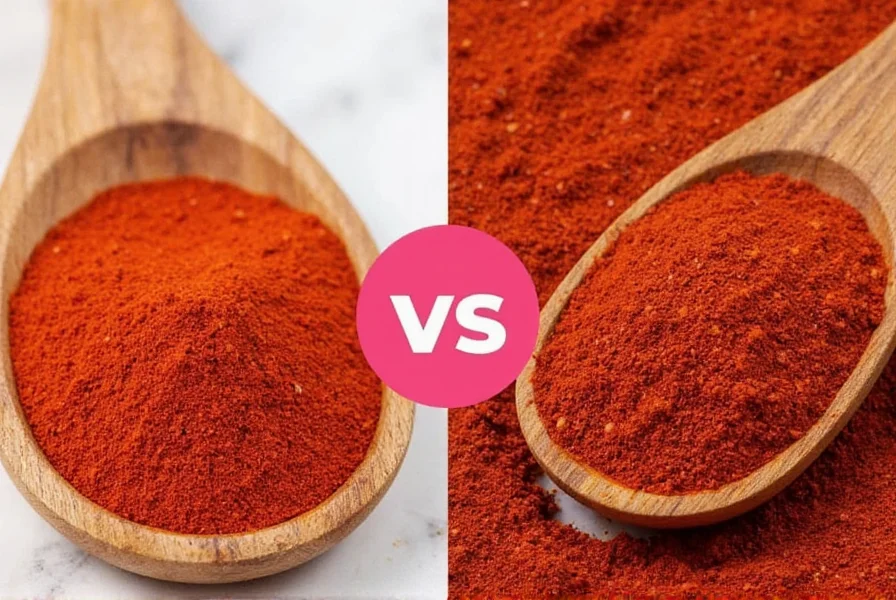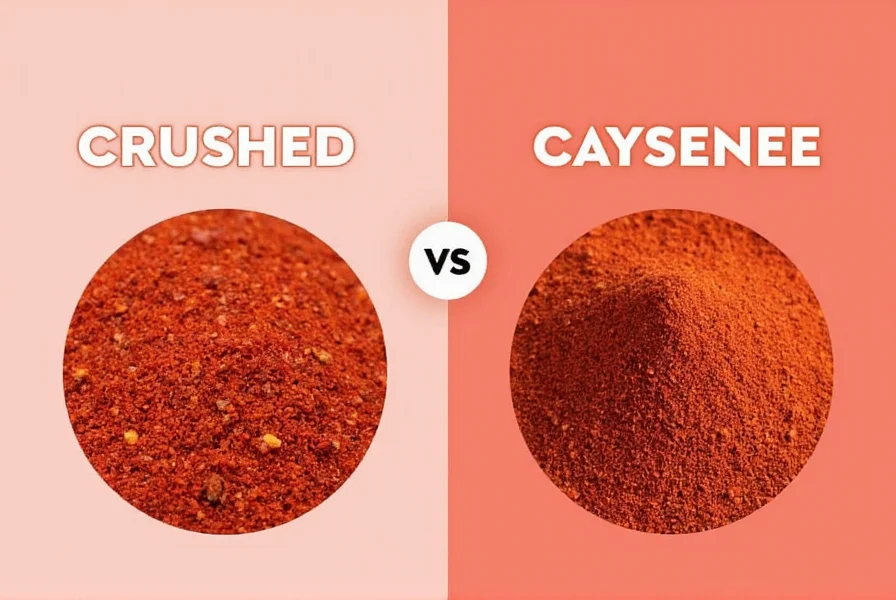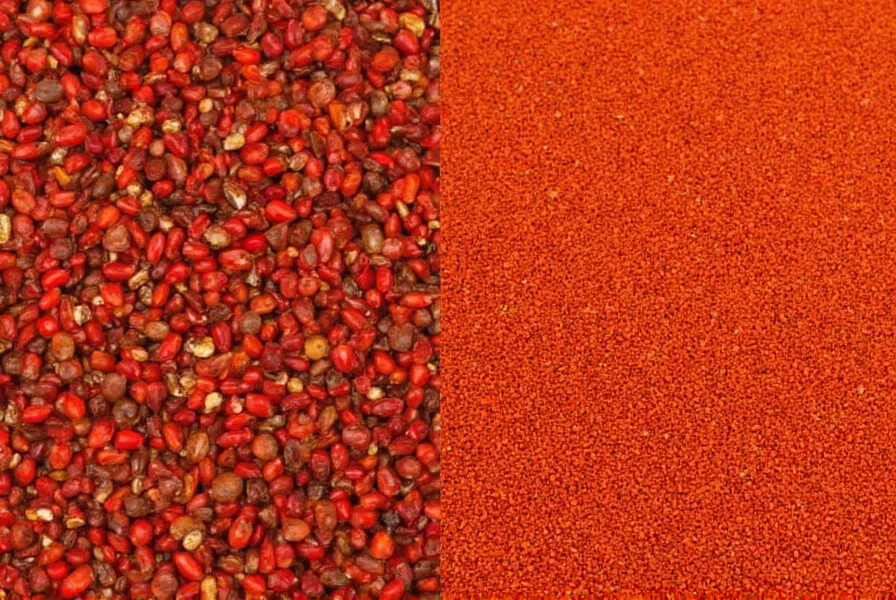Many home cooks mistakenly treat crushed red pepper and cayenne pepper as interchangeable ingredients, but they have distinct characteristics that affect both flavor and heat in culinary applications. This confusion stems from similar packaging and overlapping ingredients, yet their differences matter significantly when preparing dishes that require precise spice levels.
Composition and Ingredients
Crushed red pepper, commonly found in shaker bottles at pizza restaurants, consists of coarsely ground dried red chili peppers. Most commercial blends include a mixture of cayenne, ancho, and other red peppers, creating a complex flavor profile with varying heat levels. The visible flakes contain seeds and membrane fragments, contributing to its characteristic texture and spiciness.
Cayenne pepper, by contrast, is a single-ingredient spice made exclusively from ground cayenne peppers. This results in a fine, uniform powder with consistent heat throughout. Pure cayenne contains no additional pepper varieties, delivering a cleaner, more direct heat without the nuanced flavor notes found in crushed red pepper blends.
| Characteristic | Crushed Red Pepper | Cayenne Pepper |
|---|---|---|
| Primary Ingredients | Mixture of dried red chili peppers | 100% cayenne peppers |
| Texture | Coarse flakes with visible seeds | Fine, uniform powder |
| Heat Level (Scoville) | 5,000-30,000 units | 30,000-50,000 units |
| Flavor Profile | Complex, earthy, slightly smoky | Sharp, direct heat with citrus notes |
| Common Culinary Uses | Pizza, pasta, Mediterranean dishes | Cajun cuisine, sauces, spice blends |
Heat Level Comparison
The heat difference between these spices significantly impacts cooking results. Crushed red pepper's variable heat comes from its mixed composition—some flakes contain more seeds and membranes (the hottest parts), while others contain mostly flesh. This creates an inconsistent heat experience where one bite might be mild while the next delivers a noticeable kick.
Cayenne provides consistent, predictable heat throughout a dish. When recipes specify cayenne, they're counting on this reliability. Substituting crushed red pepper for cayenne often results in under-seasoned dishes, while using cayenne where crushed red pepper is called for can make food uncomfortably hot. Understanding crushed red pepper cayenne substitution ratios prevents these common kitchen mistakes.
Culinary Applications and Substitution Guidelines
Each spice shines in different culinary contexts. Crushed red pepper works best as a finishing spice where its texture and visual appeal matter—sprinkled on pizza, pasta, or roasted vegetables. The coarse flakes provide intermittent heat bursts that complement rather than overwhelm dishes.
Cayenne excels in recipes requiring even heat distribution, such as sauces, marinades, and spice rubs. Its fine texture allows for seamless integration into liquids and dry blends. When substituting between these spices, remember these practical guidelines:
- For every 1/4 teaspoon of cayenne, use 1/2 to 1 teaspoon of crushed red pepper
- When replacing crushed red pepper with cayenne, use one-third the amount
- Always add gradually and taste—crushed red pepper vs cayenne heat comparison shows cayenne is consistently hotter
- Consider the visual impact—cayenne won't provide the same decorative flakes

Storage and Shelf Life
Both spices lose potency over time but require similar storage conditions. Keep them in airtight containers away from light, heat, and moisture. Properly stored, crushed red pepper maintains quality for 2-3 years, while cayenne powder remains potent for 3-4 years. The coarser texture of crushed red pepper flakes composition makes it slightly more susceptible to moisture absorption than fine cayenne powder.
Test freshness by rubbing a small amount between your fingers and smelling. Fresh crushed red pepper should have a vibrant, slightly smoky aroma, while stale product smells dusty. Cayenne should have a sharp, clean scent; diminished aroma indicates reduced potency. Never store these spices above the stove where heat accelerates degradation.
Nutritional Profile and Culinary Benefits
Both spices contain capsaicin, the compound responsible for heat, which offers metabolic benefits when consumed in culinary amounts. Crushed red pepper provides slightly more fiber due to its flake structure, while cayenne delivers more concentrated capsaicin per teaspoon. Neither should be considered medicinal supplements, but both contribute to flavorful, satisfying meals when used appropriately.
Chefs seeking to understand crushed red pepper cayenne differences in cooking should remember that these spices serve different purposes in the kitchen. The texture, heat consistency, and flavor nuances make each valuable for specific applications rather than interchangeable ingredients.

Practical Kitchen Tips
When working with these spices, consider these professional techniques:
- Toast crushed red pepper flakes in olive oil before adding to dishes to mellow their heat and enhance flavor
- For even cayenne distribution in dry rubs, mix with other spices before applying to proteins
- When adjusting heat in finished dishes, crushed red pepper works better than cayenne as you can control the amount per bite
- Make your own custom crushed red pepper blend by combining cayenne with milder peppers like ancho for balanced heat
Understanding the difference between crushed red pepper and cayenne pepper transforms your cooking precision. While they share some similarities, recognizing their unique properties allows you to select the right spice for each culinary application, ensuring balanced heat and optimal flavor in every dish.











 浙公网安备
33010002000092号
浙公网安备
33010002000092号 浙B2-20120091-4
浙B2-20120091-4